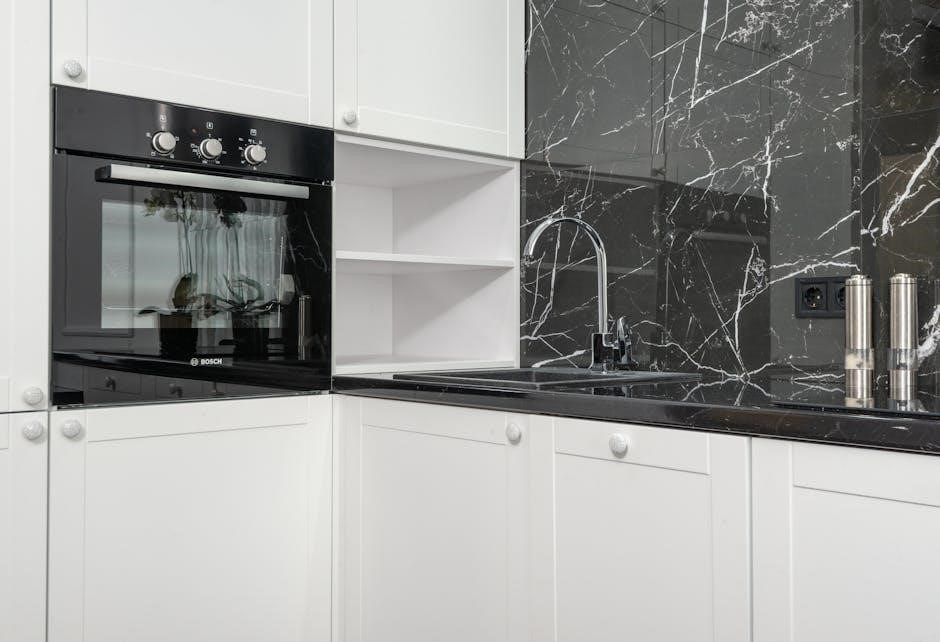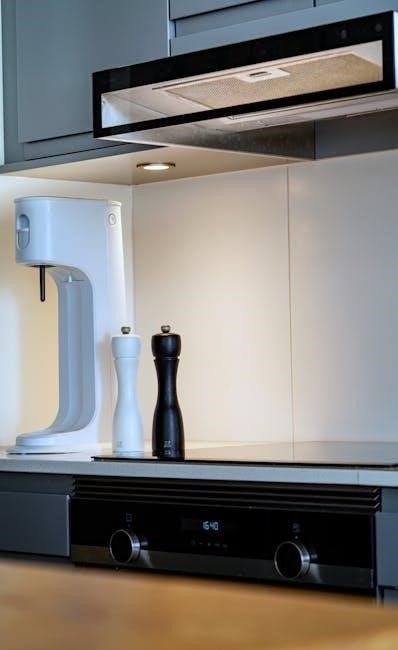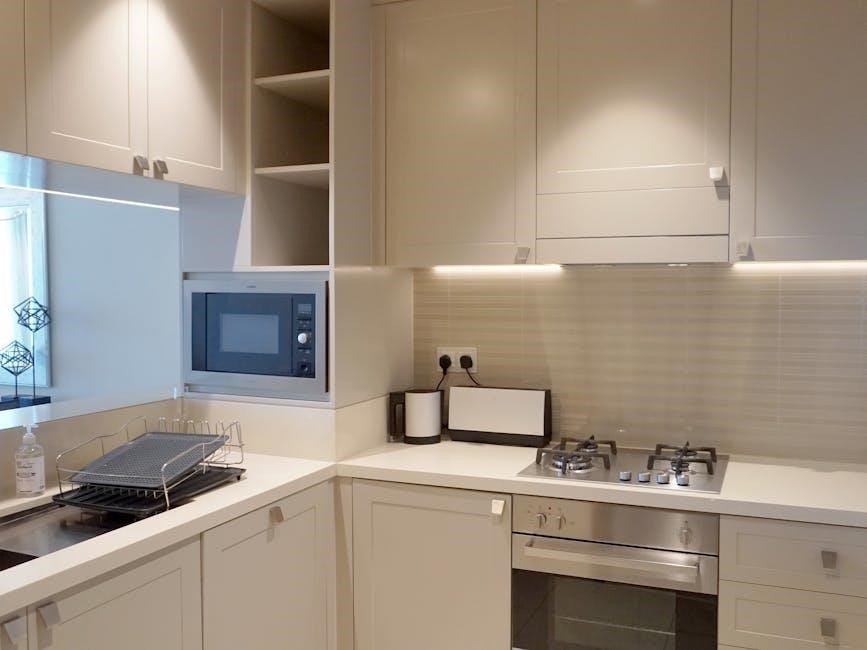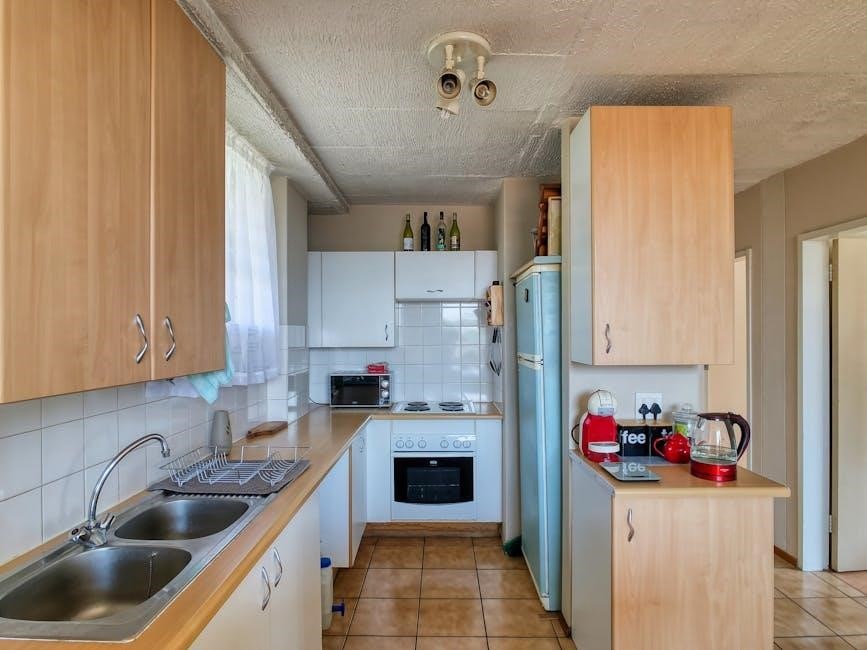The GE oven’s self-clean feature uses high heat to burn food residue‚ eliminating manual scrubbing. It’s a safe‚ efficient way to maintain your oven’s cleanliness and performance.
1.1 Overview of the Self-Clean Functionality
The self-clean functionality on General Electric ovens uses high temperatures to burn food residue into ash‚ making cleanup effortless. This feature is designed to simplify maintenance by eliminating the need for harsh chemicals or manual scrubbing. The oven door locks during the cycle to ensure safety‚ and the process typically takes several hours. It’s an energy-efficient and convenient way to keep your oven clean and hygienic. Proper preparation‚ such as removing racks and scraping large particles‚ ensures optimal results. Always refer to your specific model’s manual for detailed instructions and safety guidelines.
1.2 Benefits of Using the Self-Clean Cycle
Using the self-clean cycle on your GE oven offers numerous benefits‚ including effortless food residue removal without chemicals. It saves time by eliminating manual scrubbing and ensures a hygienic cooking environment. The high-heat process sanitizes the oven interior‚ reducing bacteria and odors. Regular use of this feature maintains your oven’s performance and appearance‚ preventing grime buildup. It also prolongs the appliance’s lifespan by keeping internal components clean. Additionally‚ the self-clean cycle is energy-efficient‚ using targeted heat to minimize waste. Overall‚ it’s a convenient and effective way to keep your oven in pristine condition while ensuring safety and efficiency.

Safety Instructions for Self-Cleaning Oven
Always keep children away during the self-clean cycle due to high temperatures. Ensure proper ventilation to avoid fumes and never use abrasive cleaners or harsh chemicals.
2.1 General Safety Precautions
Before initiating the self-clean cycle‚ ensure the oven is empty of racks and accessories to prevent damage. Keep the kitchen well-ventilated to avoid inhaling fumes. Never use abrasive cleaners or sharp objects‚ as they can damage the enamel. Always unplug the appliance before manual cleaning. Keep children and pets away due to extreme heat. Avoid opening the door during the cycle‚ as it may release harmful fumes. Follow all instructions in the GE manual carefully to ensure safety and optimal performance.

2.2 Precautions During the Cleaning Cycle
Always keep the oven door closed during the self-clean cycle to ensure safety and proper operation. Avoid using the oven for cooking during this process‚ as high temperatures can release harmful fumes. Never attempt to interrupt or stop the cycle once it has started‚ as this may damage the oven or cause burns. Do not use water to extinguish spills or flames inside the oven during cleaning‚ as it can create toxic fumes. Keep the area around the oven clear of flammable materials and ensure proper ventilation to prevent inhaling fumes. Monitor the cycle from a safe distance and follow the manual’s guidelines strictly.
2.3 Handling the Oven Door During Self-Cleaning
Keep the oven door closed throughout the self-cleaning cycle to prevent exposure to high heat and toxic fumes. Never attempt to open the door during the cycle‚ as it may cause burns or damage. Ensure the door is securely latched before starting the cycle. After the cycle completes‚ allow the oven to cool down completely before opening the door. Use oven mitts or tongs to handle any residue carefully. Do not use abrasive cleaners on the door seals or glass‚ as this may damage them. Always follow the manual’s instructions for handling the oven door during and after self-cleaning.

Preparation Steps for Self-Cleaning
Remove racks and accessories‚ scrape off large food particles‚ and ensure the oven is empty. This ensures safe and effective cleaning during the self-clean cycle.
3.1 Removing Rack and Accessories
Before initiating the self-clean cycle‚ remove all racks‚ pans‚ and accessories from the oven. These items may warp or discolor due to high temperatures. For racks‚ refer to your manual for specific removal instructions. Utensils like trays or grill racks should also be taken out to ensure thorough cleaning. If racks need cleaning‚ wash them manually with detergent or place them in the dishwasher. Never leave metal accessories inside during the self-clean cycle‚ as they may damage the oven lining. Always ensure the oven is completely empty before starting the process for safe and effective cleaning.
3.2 Scrape Off Large Food Particles
Before starting the self-clean cycle‚ scrape off large food particles using a plastic scraper or soft cloth. Avoid using sharp objects or abrasive materials‚ as they may damage the oven’s enamel. Lightly wipe the interior to remove loose debris. For tough residue‚ mix baking soda and water to create a paste‚ apply it‚ and let it sit overnight. This step prevents excessive smoke during the self-clean cycle. Never use detergents or harsh chemicals‚ as they can leave harmful residues. Always ensure the oven is cool before scraping to avoid burns. This preparation ensures a safer and more efficient cleaning process.
3.4 Ensuring the Oven is Empty
Before initiating the self-clean cycle‚ it is crucial to ensure the oven is completely empty. Remove all racks‚ shelves‚ and utensils to prevent damage and ensure optimal cleaning. The high heat generated during the cycle can cause any remaining items to warp or become discolored. Additionally‚ an empty oven allows the self-clean feature to function more effectively‚ targeting all interior surfaces without obstruction. This step is essential for both safety and the efficiency of the cleaning process.

Operating the Self-Clean Cycle
Start by ensuring the oven is empty and all racks are removed. Locate the self-clean option on your oven controls‚ typically marked as “Clean” or “Self-Clean.” Press and hold the button if required‚ then select the desired cleaning time or temperature setting. Some models may automatically lock the oven door for safety. Monitor the cycle to ensure it progresses smoothly. If smoke appears‚ ventilate the area slightly. Once complete‚ let the oven cool before wiping away residue. Always refer to your specific model’s manual for precise instructions.
4.1 Starting the Self-Clean Cycle
To initiate the self-clean cycle‚ press and hold the latch release button while sliding the oven latch to the “Clean” position. Turn the oven set and temperature knobs clockwise to the “Clean” setting. If your model lacks a specific “Clean” position‚ set the temperature knob to any high temperature. Ensure the oven door is securely locked‚ as it may automatically lock during the cycle. Refer to your specific model’s manual for exact instructions‚ as controls may vary. Open windows for ventilation and avoid interrupting the cycle once it begins for optimal cleaning and safety.
4.2 Setting the Oven Controls for Cleaning
Locate the oven controls and select the “Self-Clean” or “Clean” option. Turn the oven set knob clockwise to the “Clean” position. If your model doesn’t have a dedicated “Clean” setting‚ set the temperature knob to the highest heat level. Ensure the oven door is fully closed and locked‚ as the cycle cannot start if the door is ajar. For models with a latch release button‚ press and hold it while sliding the latch to the “Clean” position. Verify that all controls are correctly set before starting the cycle to ensure proper operation and safety.
4.3 Monitoring the Cleaning Process
During the self-clean cycle‚ the oven will heat to very high temperatures to burn away food residue. Keep the kitchen well-ventilated to avoid fumes. Do not open the oven door during cleaning‚ as it may release harmful smoke. Monitor the process through the oven light if available. Listen for unusual sounds‚ as the intense heat may cause popping or cracking noises. Stay nearby to ensure the cycle progresses safely. Avoid interrupting the cycle until it completes‚ as this could damage the oven. Once done‚ allow the oven to cool before proceeding with post-cleaning steps.
4.4 Completing the Cycle
Once the self-clean cycle is complete‚ the oven will automatically shut off. Allow the oven to cool completely before opening the door or touching any surfaces‚ as they will be extremely hot. When cool‚ inspect the interior to ensure all food residue has been reduced to ash. Use a damp cloth to wipe away any remaining ash and residue. Check for any stubborn spots that may require additional cleaning. Properly dispose of the ash and cleaning materials. Refer to your GE oven manual for specific instructions tailored to your model for the best results.

Post-Cleaning Procedures
After the self-clean cycle‚ let the oven cool completely. Wipe the interior with a damp cloth to remove ash and residue. Dispose of ash properly and rinse the cloth thoroughly. Ensure all surfaces are clean before restarting the oven for cooking. Refer to your GE manual for model-specific post-cleaning steps to maintain optimal performance and safety.

5.1 Allowing the Oven to Cool Down
After the self-clean cycle completes‚ turn off the oven and allow it to cool completely. This ensures safety and prevents damage to the oven’s components. Keep the oven door closed during the cooling process to retain heat evenly. Avoid touching the oven surfaces‚ as they remain extremely hot for several hours. Letting the oven cool down naturally helps prevent thermal shock and ensures the self-cleaning process is effective. Always wait until the oven is cool before wiping down surfaces or restarting it for cooking. Refer to your GE manual for specific cooling time recommendations based on your model.
5.2 Wiping Down the Oven Interior
After the oven has cooled‚ use a damp cloth to wipe down the interior surfaces. This removes any ash or residue left from the self-clean cycle. Avoid using abrasive materials or harsh chemicals‚ as they can damage the oven’s finish; For stubborn spots‚ a mild detergent mixed with warm water can be used‚ but ensure the oven is completely cool first. Wipe in a gentle‚ even motion to prevent scratching. Remove all residue thoroughly to maintain the oven’s performance and appearance. Regular wiping helps keep the oven clean and ready for future use.
5.3 Disposing of Food Residue
After the self-clean cycle‚ food residue is reduced to ash. Allow the oven to cool completely before handling. Use a soft brush or damp cloth to collect the ash‚ ensuring no particles remain. Avoid using abrasive materials that could scratch the oven surfaces. Properly dispose of the collected ash in a sealed container to prevent dust dispersal. This step ensures the oven remains clean and ready for its next use. Always handle the ash carefully to avoid spills and maintain a tidy kitchen environment.

Maintenance Tips for Optimal Performance
Regularly clean the oven exterior and check for worn-out parts. Ensure proper ventilation for efficient operation. Replace oven lamps as needed for visibility during cooking and cleaning cycles.
6.1 Regular Cleaning of Oven Exterior
Regularly clean the oven exterior to maintain its appearance and functionality. Use a damp cloth to wipe down surfaces‚ avoiding abrasive materials that could scratch the finish. For tougher stains‚ apply a mild detergent or specialized oven cleaner‚ following the product’s instructions. Ensure the oven is cool before cleaning to prevent burns. Pay attention to knobs‚ handles‚ and vents‚ as these areas tend to accumulate grime. Avoid using harsh chemicals or scouring pads‚ as they may damage the enamel or metallic surfaces. Drying the exterior with a clean towel will prevent water spots and maintain a polished look.
6.2 Checking and Replacing Oven Lamps
Regularly inspect the oven lamp to ensure it’s functioning properly. A faulty lamp can hinder visibility during cooking. To replace the lamp‚ first turn off the oven and allow it to cool completely. Locate the lamp compartment‚ typically behind a glass cover at the rear or top of the oven. Remove the cover‚ then gently pull out the old lamp and insert a new one compatible with your GE oven model. Ensure the lamp is securely seated and the cover is properly replaced. Always use genuine GE parts for optimal performance and safety.
6.3 Maintaining Oven Ventilation
Proper ventilation is crucial for efficient oven operation and safety. Ensure your kitchen is well-ventilated‚ especially during self-cleaning cycles‚ to prevent smoke and fumes from accumulating. Regularly inspect and clean vents or exhaust fans to ensure they function correctly. If your oven is equipped with a ventilation system‚ follow the manufacturer’s guidelines for maintenance. Always use genuine GE parts for any replacements to maintain performance and safety. Proper ventilation helps reduce odors and ensures a safe cooking environment while prolonging the life of your oven.

Troubleshooting Common Issues
Address common issues like malfunctioning heating elements‚ excessive smoke‚ or door latch problems. Consult the manual for solutions or contact GE support for professional assistance.
7.1 Oven Not Heating During Self-Clean
If the oven doesn’t heat during self-cleaning‚ ensure the door latch is fully engaged and controls are set correctly. Check circuit breakers or fuses. If issues persist‚ refer to the GE manual or contact customer support for assistance. Always unplug the appliance before performing diagnostics to ensure safety. Regular maintenance‚ like cleaning sensors‚ can prevent such issues. Follow the troubleshooting guide in the manual for specific model instructions.
7.2 Smoke or Odors During Cleaning
Smoke or odors during self-cleaning are normal due to food residue burning at high temperatures. Ensure proper ventilation by opening windows or using an exhaust fan. If smoke persists‚ check for excessive food buildup and scrape large particles before starting. Avoid opening the oven door during the cycle. If odors linger after cleaning‚ wipe the interior with a solution of water and vinegar once cool. Always follow the GE manual’s guidelines for safe and effective cleaning. If issues persist‚ consult the troubleshooting section or contact GE support for assistance.
7.3 Oven Door Malfunction
If the oven door malfunctions during self-cleaning‚ ensure it is fully locked before starting the cycle. If the door doesn’t lock properly‚ the cycle won’t start. If it jams or won’t open after cleaning‚ let it cool completely before attempting to open. Avoid forcing the door‚ as this can cause damage. If issues persist‚ consult the GE manual or contact customer support for assistance. Regular maintenance‚ like checking door hinges and locks‚ can prevent such malfunctions. Always follow safety guidelines to avoid accidents or further damage to the oven.

General Electric Oven Manual References
Refer to the GE oven manual for detailed self-clean instructions‚ warranty information‚ and customer support contacts. Online resources and troubleshooting guides are also available for assistance.
8.1 Locating the Self-Clean Instructions in the Manual
The self-clean instructions are typically found in the maintenance or cleaning section of the GE oven manual. Start by reviewing the table of contents or index for keywords like “self-clean” or “auto-clean.” Detailed steps‚ safety precautions‚ and cycle operation are provided. Ensure to read the safety information first to avoid accidents. The manual may also include troubleshooting tips for common issues during the cleaning process. For digital access‚ visit the GE Appliances website to download the manual or view online resources for additional guidance. Always follow the manual’s instructions for optimal results.
8.2 Understanding Warranty and Support Information
GE Appliances offers a comprehensive warranty for their self-cleaning ovens‚ covering parts and labor for a specified period; Refer to the warranty section in the manual for details. For support‚ visit the GE Appliances website or contact their customer service. Online resources include troubleshooting guides and FAQs. Register your appliance online to activate warranty benefits and access exclusive support features. For additional assistance‚ consult the manual or reach out to GE’s dedicated customer care team. Always ensure you understand the terms and conditions of your warranty for optimal coverage and support.
8.3 Accessing Online Resources for Additional Guidance
GE Appliances provides extensive online resources to support your self-cleaning oven. Visit their official website to access digital manuals‚ troubleshooting guides‚ and FAQs. You can also register your appliance online to activate warranty benefits and gain access to exclusive support features. For further assistance‚ explore the “Consumer Support” section‚ which offers helpful websites and phone numbers. Additionally‚ GE’s website hosts installation instructions‚ Quick Specs‚ and Energy Guide labels for your reference. Utilize these resources to ensure optimal use and maintenance of your self-cleaning oven.